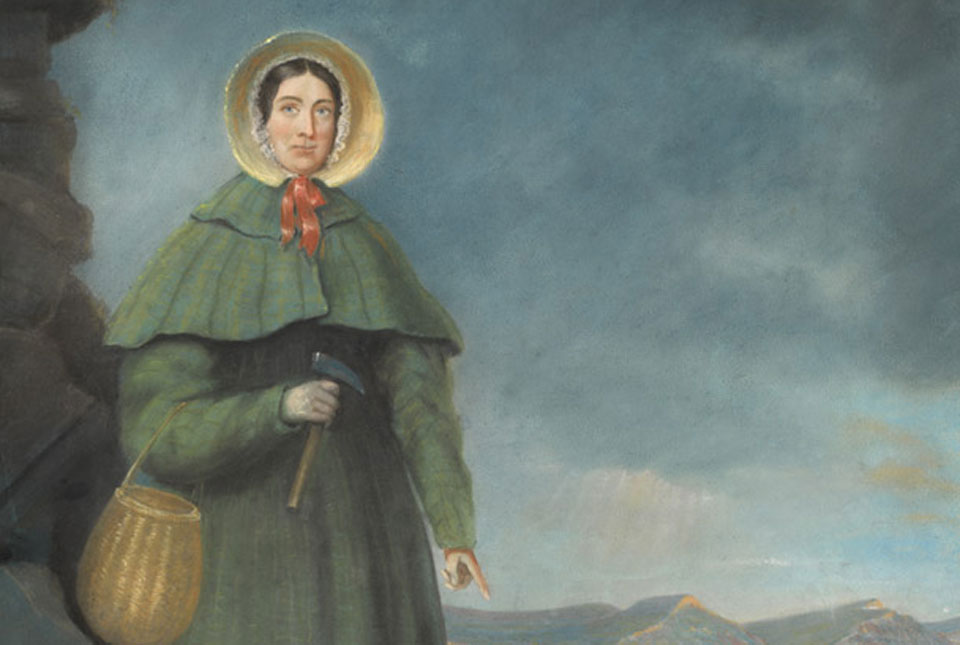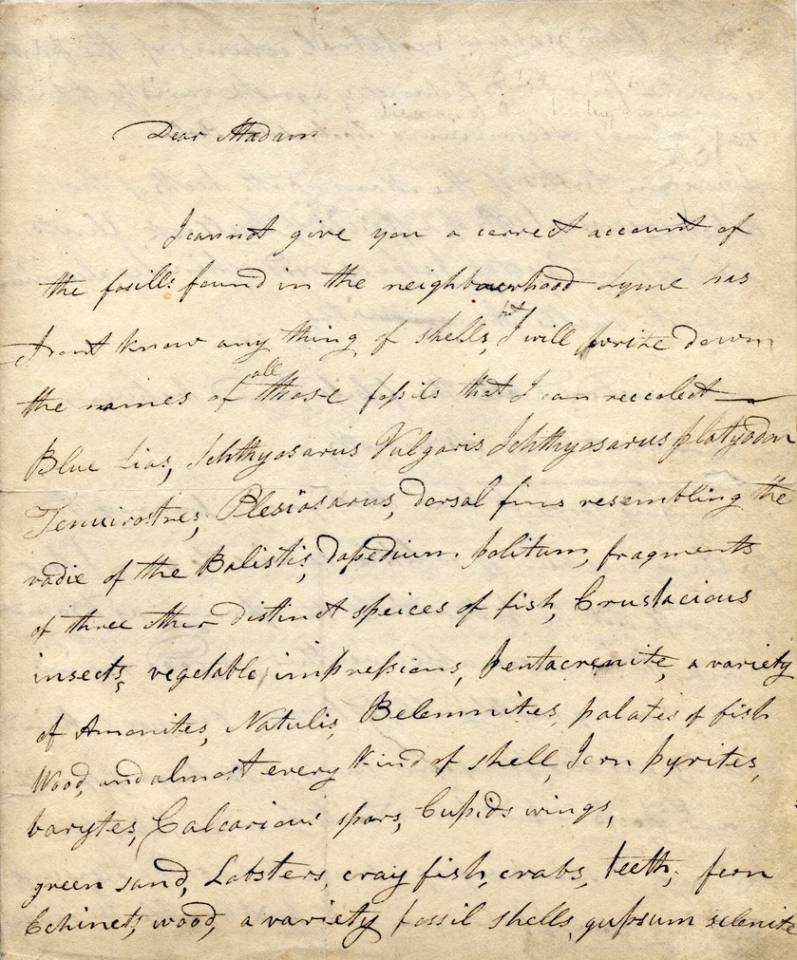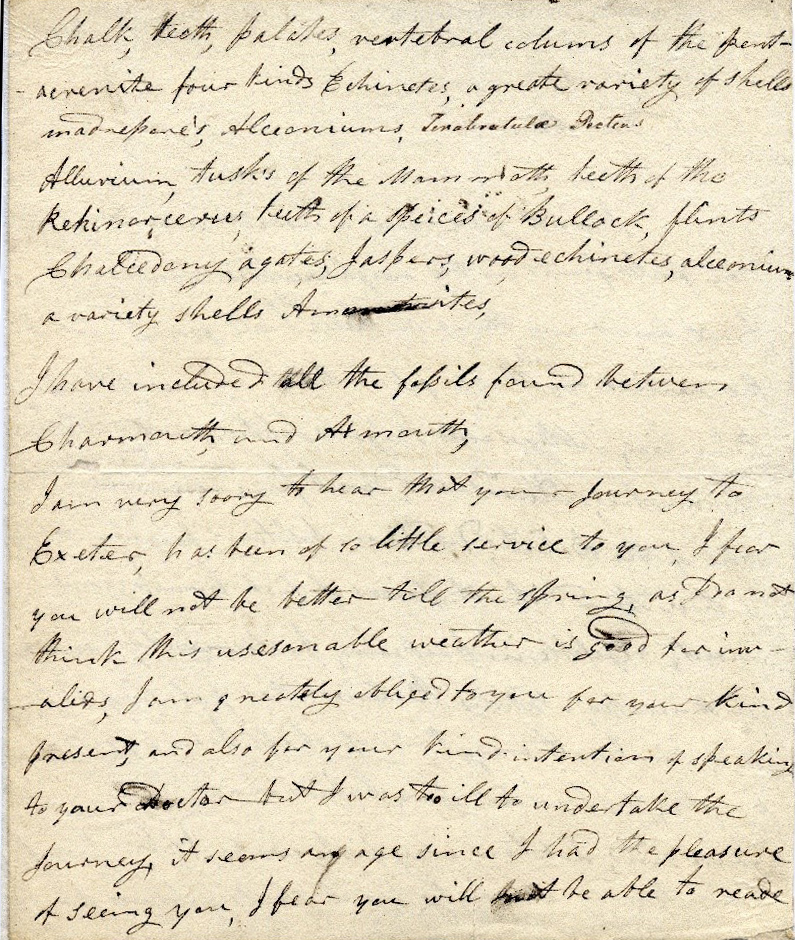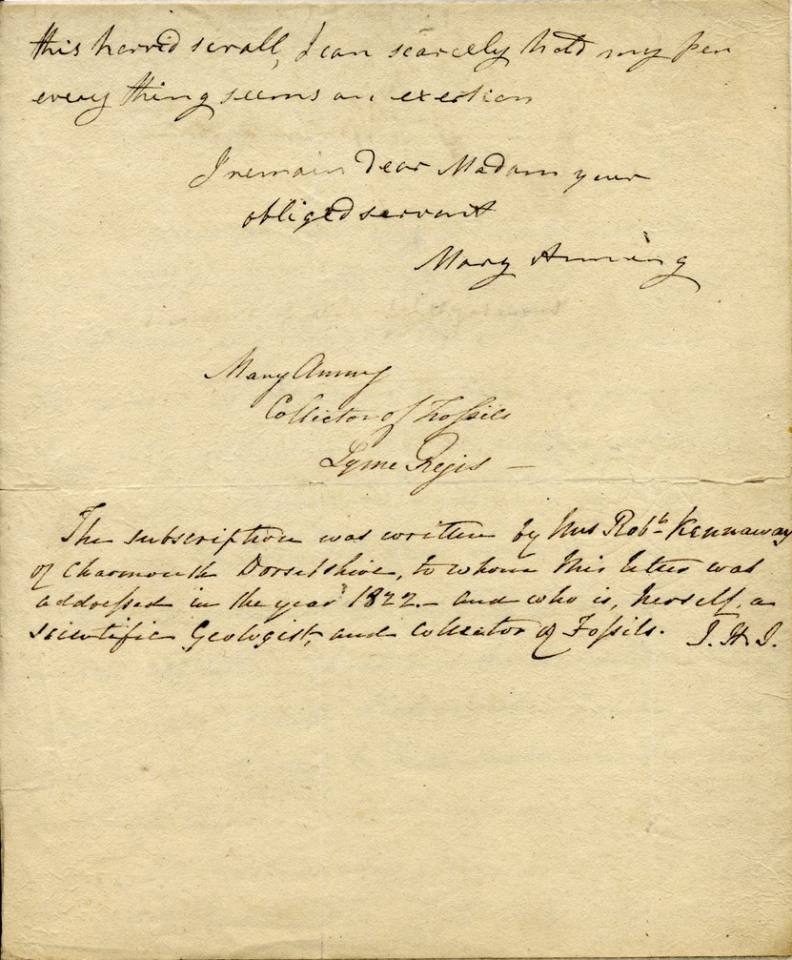Mary Anning: a remarkable fossil collector
Simon Harris explains what a letter, sent by Anning in 1822, can tell us about her life and work at the time.
19/04/2021
Mary Anning is known as one of the most celebrated fossil hunters in the UK. Her pioneering work was undertaken around the Jurassic Coast in Dorset, where she found, amongst many others, ichthyosaur, pterosaur and plesiosaur fossils. Here, BGS Conservator, Simon Harris, talks us through a letter from Anning, sent in 1822, and what this letter can tell us about her life and work at the time.
Transcript
Dear Madam
I cannot give you a correct account of the fossills found in the neighbourhood Lyme has I dont know any thing of shells, but I will write down the names of all those fossils that I can reccolect.
Blue Lias, Ichthyosarus vulgaris, Icthyosarus platydon Tenuirostis, Plesiosarus, dorsal fins resembling the radie of Balistis, dapedium politum, fragments of three other distinct species of fish, Crustacions insects, vegetable impressions, pentacrenite, a variety of Amonites, Natulis, Belemnites, palates of fish Wood, and almost every kind of shell, Iron pyrites, barytes, Calcarious spars, Cupids wings, green sand, Lobsters, cray fish, crabs, teeth, fern Echinets, wood, a variety of fossil shells, gupsum selenite Chalk, teeth, palates, vertebral colums of pentacrenite four kinds of Echinetes, a greate variety of shells madrepore’s, Alceoniums,Terabratulae Pectens
Alluvium, tusks of the mammoth, teeth of the Rehinocerus, teeth of a species of Bullock, flints Chalcedony agates, jaspers, wood echinetes, alceonium a variety of shells Amonites,
I have included all the fossils found between Charmouth, and Axmouth,
I am very sorry to hear your journey to Exeter, has been of so little service to you, I fear you will not be better till the spring, as I cannot think this usesonable weather is good for invalids, I am greatly obliged to you for your kind present, and also for your kind intentions of speaking to your doctor but I was too ill to undertake the journey, it seems an age since I had the pleasure of seeing you, I fear you will not be able to reade this horrid scrall, I can scarcely hold any pen everything seems an exertion
I remain dear madam your
obliged servant
Mary AnningMary Anning
Collector of Fossils
Lyme RegisThe subscription was written by Mrs Robt. Kennaway of Charmouth Dorsetshire, to whom this letter was addresses in the year 1822.- and who herself is a scientific geologist, and collector of fossils.
J.H.S.
This is a fascinating letter. Although we do not have the letter which prompted this response, it clearly answers the question which thousands of visitors to the Jurassic Coast ask to this very day, namely: ‘What fossils can I find here?’
Even in her early twenties, Mary Anning demonstrates in her letter a thorough knowledge of the rocks between Axmouth and Charmouth, around a 10 mile stretch of coast with Lyme Regis at its centre, which probably represents the furthest she would have been able to walk in a day, not having access to any other form of transport.
In the letter, she correctly and concisely lists fossils that would be familiar to collectors today:
- the three most common species of ichthyosaur found, Ichthyosaurus vulgaris (now called I. communis), I. platyodon, and I. tenuirostris
- the Plesiosaurus, which was at that point still very new to science — in 1823 Anning would discover a spectacular complete specimen, which would enable the full description of Plesiosaurus dolichodeirus to be completed by William Conybeare
- the existence of at least four different kinds of fish
- much of the invertebrate fauna, including the ever-present ammonites, belemnites and crinoids (‘pentacrenite’, known today as Pentacrinus)
- the presence of wood and vegetable impressions (probably leaf impressions, which are found occasionally), which indicate that there was land not very far away from where the fossils were being formed
She is also aware that certain fossils are found in certain rocks, and not in others, demonstrating an underlying knowledge of the local stratigraphy.
Anning uses scientific terms wherever possible and, where not, tries to draw on the similarities with modern species with which she is familiar through her limited access to books and scientific papers, which we know she sometimes was able to borrow and would labouriously copy out by hand. For example ‘dorsal fins resembling the radie of the Balistis’ may refer to the modern Balistes, a triggerfish. The fossils themselves may be the rarely found spines of cartilaginous shark species; later she would discover remains in the rocks near Lyme Regis that would permit a fuller description of these fossils.
We see relatively few uses of folklore terminology for fossils despite the fact that, at this time, use of these descriptions to explain the strange anomalies found in the rocks would have been commonplace. Think, for example, of the terms ’snakestone‘ to describe ammonites, ’sea dragons‘ for marine reptiles, ‘Cupid’s wings’, possibly referring to some species of bivalve or brachiopod shell, or ’fairy loaves‘ for sea urchins. This demonstrates that Anning had built an impressive scientific understanding of her finds, even without access to the level of formal education held by the men of science with whom she would correspond.
There are very few notable omissions from Anning’s list, but one to mention is of ’bezoar stones‘ or as we now call them, coprolites (fossil faeces). We know that it wasn’t until 1824 that Anning began to make the connection between these unusually shaped stones and the animals that made them, although it is probable that she had encountered them many years before.
This letter still stands as a remarkably complete account of fossils that are found around Lyme Regis to this very day. If you were to ask a local collector the same question today, you would receive an answer that was not very much different! It shows us that Mary Anning was an extremely skilled and knowledgeable fossil collector, who made every effort to learn as much about the things she was collecting as she possibly could.
About the author

Simon Harris
Collections conservation and digitisation manager







